刘润清《新编语言学教程》笔记和课后习题(形态学)【圣才出品】
- 格式:pdf
- 大小:710.35 KB
- 文档页数:32
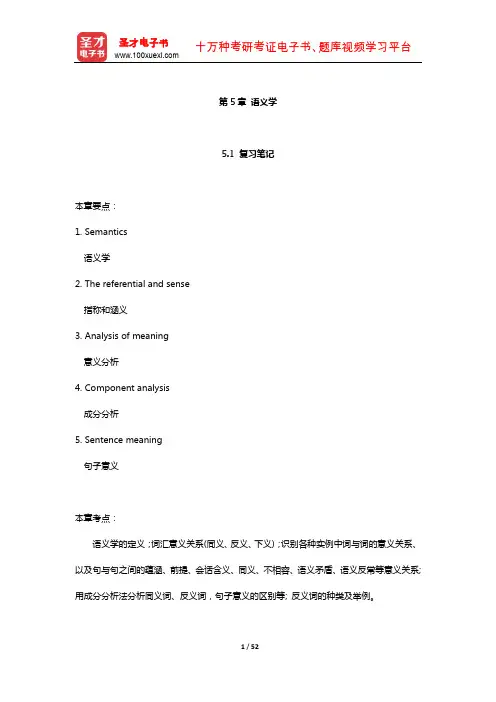
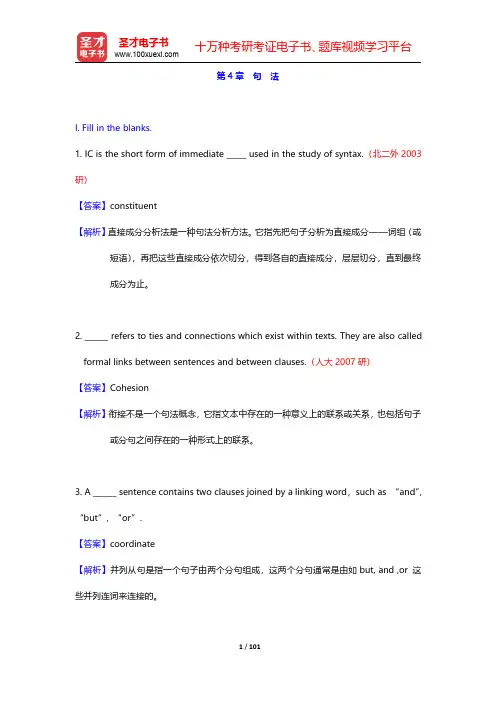
第4章句法I.Fill in the blanks.1.IC is the short form of immediate_____used in the study of syntax.(北二外2003研)【答案】constituent【解析】直接成分分析法是一种句法分析方法。
它指先把句子分析为直接成分——词组(或短语),再把这些直接成分依次切分,得到各自的直接成分,层层切分,直到最终成分为止。
2.______refers to ties and connections which exist within texts.They are also called formal links between sentences and between clauses.(人大2007研)【答案】Cohesion【解析】衔接不是一个句法概念,它指文本中存在的一种意义上的联系或关系,也包括句子或分句之间存在的一种形式上的联系。
3.A______sentence contains two clauses joined by a linking word,such as“and”,“but”,“or”.【答案】coordinate【解析】并列从句是指一个句子由两个分句组成,这两个分句通常是由如but,and,or这些并列连词来连接的。
4.A clause that takes a subject and a finite verb,and at the same time stands structurally alone is known as a______clause.【答案】finite【解析】限定性从句通常有一个主语和一个限定性动词,且在结构上是独立的。
5.Syntactic movement is dictated by rules traditionally called_____rules,whose operation may change the syntactic representation of a sentence.【答案】transformational【解析】句法移位是一种转换规则,指一个句子的任意成分从原来的位置移到另一个新位置。
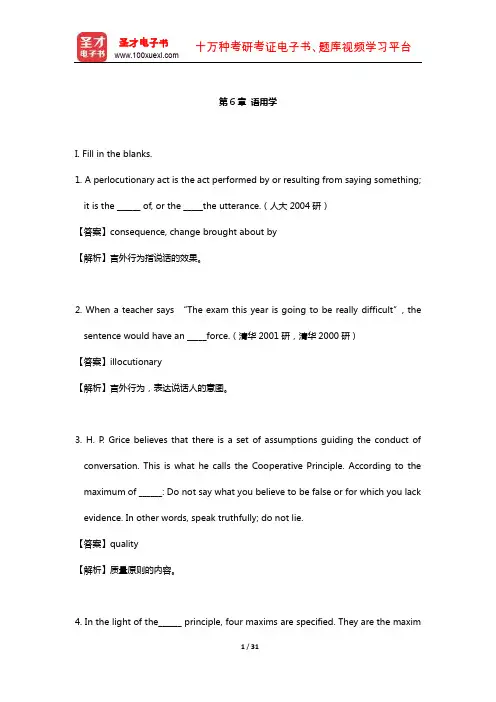
第6章语用学I. Fill in the blanks.1. A perlocutionary act is the act performed by or resulting from saying something; it is the ______ of, or the _____the utterance.(人大2004研)【答案】consequence, change brought about by【解析】言外行为指说话的效果。
2. When a teacher says “The exam this year is going to be really difficult”, the sentence would have an _____force.(清华2001研,清华2000研)【答案】illocutionary【解析】言外行为,表达说话人的意图。
3. H. P. Grice believes that there is a set of assumptions guiding the conduct of conversation. This is what he calls the Cooperative Principle. According to the maximum of ______: Do not say what you believe to be false or for which you lack evidence. In other words, speak truthfully; do not lie.【答案】quality【解析】质量原则的内容。
4. In the light of the______ principle, four maxims are specified. They are the maximof quantity, maxim of______, maxim of______ and the maxim of______.(中国人民大学2005年、吉林大学2004年研)【答案】cooperative; quality; relation; manner【解析】考查合作原则及四条次则:数量准则、质量准则、关联准则、方式准则。
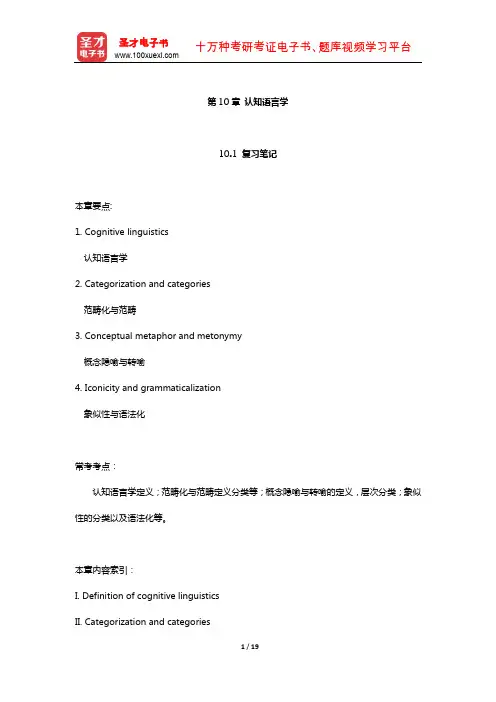
第10章认知语言学10.1 复习笔记本章要点:1. Cognitive linguistics认知语言学2. Categorization and categories范畴化与范畴3. Conceptual metaphor and metonymy概念隐喻与转喻4. Iconicity and grammaticalization象似性与语法化常考考点:认知语言学定义;范畴化与范畴定义分类等;概念隐喻与转喻的定义,层次分类;象似性的分类以及语法化等。
本章内容索引:I. Definition of cognitive linguisticsII. Categorization and categories1. Definition of categorization2. The classical theory3. The prototype theory4. Levels of categorizationIII. Conceptual metaphor and metonymy1. Conceptual metaphor2. Conceptual metonymyIV. Iconicity1. Iconicity of order2. Iconicity of distance3. Iconicity of complexityV. GrammaticalizationI. Definition of cognitive linguistics (认知语言学定义)【考点:名词解释】Cognitive linguistics is an approach to the analysis of natural language that focuses on language as an instrument for organizing, processing, and conveying information.认知语言学是一种研究自然语言的方法,集中研究语言组织,处理与传达信息的作用。
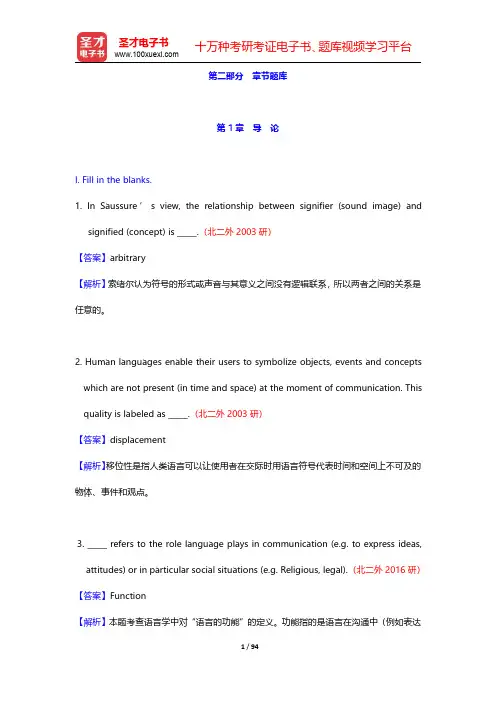
第二部分章节题库第1章导论I.Fill in the blanks.1.In Saussure’s view,the relationship between signifier(sound image)andsignified(concept)is_____.(北二外2003研)【答案】arbitrary【解析】索绪尔认为符号的形式或声音与其意义之间没有逻辑联系,所以两者之间的关系是任意的。
2.Human languages enable their users to symbolize objects,events and concepts which are not present(in time and space)at the moment of communication.This quality is labeled as_____.(北二外2003研)【答案】displacement【解析】移位性是指人类语言可以让使用者在交际时用语言符号代表时间和空间上不可及的物体、事件和观点。
3._____refers to the role language plays in communication(e.g.to express ideas, attitudes)or in particular social situations(e.g.Religious,legal).(北二外2016研)【答案】Function【解析】本题考查语言学中对“语言的功能”的定义。
功能指的是语言在沟通中(例如表达观点、态度)或在特定社交场合(如宗教、法律)中所起的作用。
4.The features that define our human languages can be called_____features.(北二外2006研)【答案】design【解析】人类语言区别于其他动物交流系统的特点是语言的区别特征,是人类语言特有的特征。
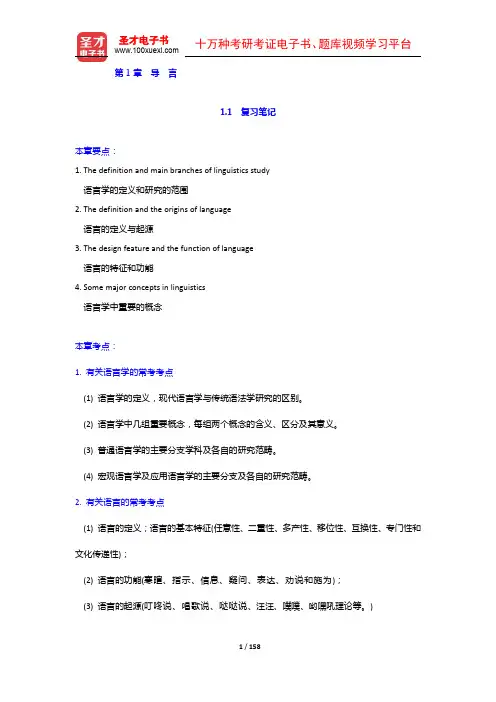
第1章导言1.1复习笔记本章要点:1.The definition and main branches of linguistics study语言学的定义和研究的范围2.The definition and the origins of language语言的定义与起源3.The design feature and the function of language语言的特征和功能4.Some major concepts in linguistics语言学中重要的概念本章考点:1.有关语言学的常考考点(1)语言学的定义,现代语言学与传统语法学研究的区别。
(2)语言学中几组重要概念,每组两个概念的含义、区分及其意义。
(3)普通语言学的主要分支学科及各自的研究范畴。
(4)宏观语言学及应用语言学的主要分支及各自的研究范畴。
2.有关语言的常考考点(1)语言的定义;语言的基本特征(任意性、二重性、多产性、移位性、互换性、专门性和文化传递性);(2)语言的功能(寒暄、指示、信息、疑问、表达、劝说和施为);(3)语言的起源(叮咚说、唱歌说、哒哒说、汪汪、噗噗、哟嘿吼理论等。
)本章内容索引:I.Definition of linguisticsII.Linguistics vs.traditional grammarIII.Scope of linguistics1.Microlinguistics2.MacrolinguisticsIV.Definition of languageV.Origins of language1.Ding-Dong Theory2.Sing-Song Theory3.Pooh-Pooh Theory4.Yo-He-Ho Theory5.Ta-Ta Theory6.Bow-Wow TheoryVI.Design features of language1.Arbitrariness2.Duality3.Productivity4.Interchangeability5.Displacement6.Specialization7.Cultural transmissionVII.Functions of language1.Phatic function/communion2.Directive functionrmative function4.Interrogative function5.Expressive function6.Evocative function7.Performative functionVIII.Some major concepts in linguistics1.Descriptive and prescriptive grammar2.Synchronic and diachronic linguisticsngue and parolepetence and performance5.Syntagmatic and paradigmatic relations6.Functionalism and formalismI.Definition of linguistics(语言学的定义)【考点:名词解释】The scientific or systemic study of language,which is always guided by the-three canons ofscience:exhaustiveness,consistency and economy.语言学是对语言的科学或系统的研究。
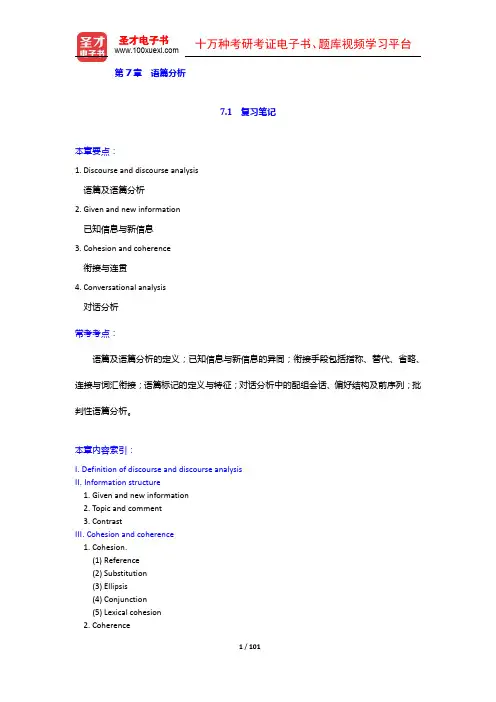
第7章语篇分析7.1复习笔记本章要点:1.Discourse and discourse analysis语篇及语篇分析2.Given and new information已知信息与新信息3.Cohesion and coherence衔接与连贯4.Conversational analysis对话分析常考考点:语篇及语篇分析的定义;已知信息与新信息的异同;衔接手段包括指称、替代、省略、连接与词汇衔接;语篇标记的定义与特征;对话分析中的配组会话、偏好结构及前序列;批判性语篇分析。
本章内容索引:I.Definition of discourse and discourse analysisrmation structure1.Given and new information2.Topic and comment3.ContrastIII.Cohesion and coherence1.Cohesion.(1)Reference(2)Substitution(3)Ellipsis(4)Conjunction(5)Lexical cohesion2.CoherenceIV.Discourse markers1.Definition2.Functional-pragmatic nature3.Features of discourse markersV.Conversational analysis1.Adjacency pairs2.Preference structure3.PresequencesVI.Critical discourse analysisI.Definition of discourse and discourse analysis(语篇及语篇分析的定义)1.Discourse(语篇)A general term for examples of language use,nguage which has been produced as the result of an act of communication.It refers to the larger units of language such as paragraphs, conversations,and interviews.泛指语言的运用,也就是说,语篇是人们进行交流的产物。
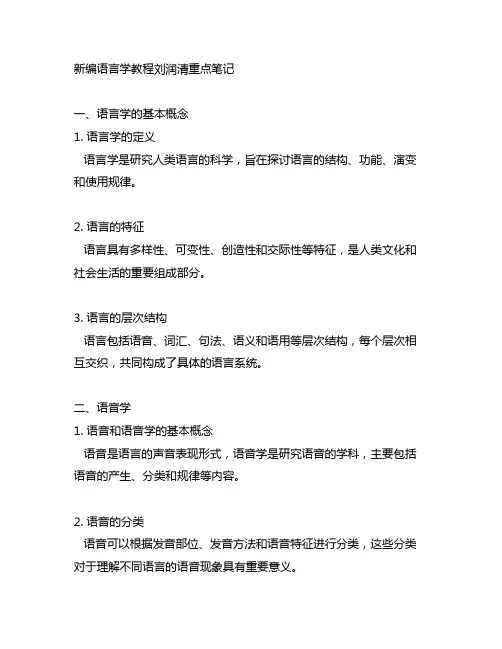
新编语言学教程刘润清重点笔记一、语言学的基本概念1. 语言学的定义语言学是研究人类语言的科学,旨在探讨语言的结构、功能、演变和使用规律。
2. 语言的特征语言具有多样性、可变性、创造性和交际性等特征,是人类文化和社会生活的重要组成部分。
3. 语言的层次结构语言包括语音、词汇、句法、语义和语用等层次结构,每个层次相互交织,共同构成了具体的语言系统。
二、语音学1. 语音和语音学的基本概念语音是语言的声音表现形式,语音学是研究语音的学科,主要包括语音的产生、分类和规律等内容。
2. 语音的分类语音可以根据发音部位、发音方法和语音特征进行分类,这些分类对于理解不同语言的语音现象具有重要意义。
3. 语音的运用语音系统是语言的基础,正确、标准的语音能够促进交际的顺利进行,也是语音教学的重要内容。
三、语音变化规律1. 语音演变的观点语音演变是语言发展的必然规律,主要有自然演变和人为干预两种形式。
2. 语音演变的原因语音演变的原因有内在原因和外在原因两类,其中心理因素和社会因素是主要的影响因素。
3. 语音演变的类型语音演变的类型包括同化、咀嚼、发音简化、重音移位和音位交替等,这些类型在不同语言中都有所体现。
四、词汇学1. 词汇的概念词汇是语言中最基本的语言单位,包括单词和词组两种形式,构成了语言的基本载体。
2. 词与词的关系词的构词规律和词的语义关系是词汇学的重要研究内容,也是词汇教学中需要重点关注的问题。
3. 词的分类词可根据词性、构词法、语义感情色调和语言长短等属性进行分类,不同的分类体系能够为语言的学习和教学提供指导。
五、句法学1. 句法结构的基本要素句法结构主要包括主语、谓语、宾语等要素,这些要素之间的组合形式决定了句子的结构类型。
2. 句法关系的层次结构句法关系包括层级结构和包含关系,这些关系是句子语法结构的重要组成部分。
3. 句法结构的功能句法结构的功能包括构句、分句和复句等,这些功能是语法结构的基本表现形式。
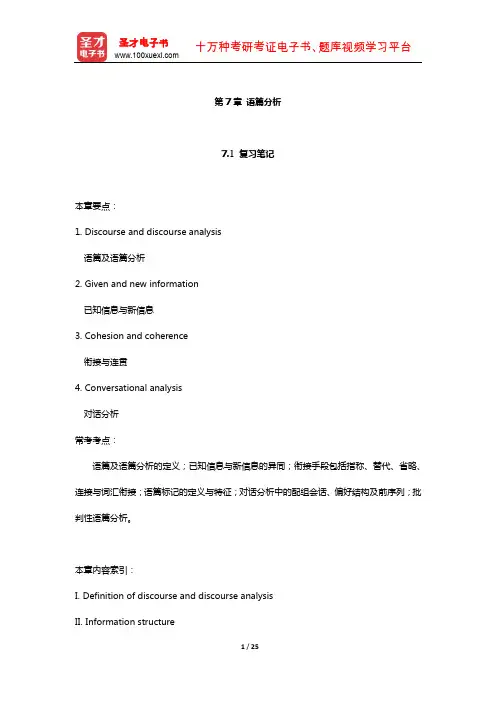
第7章语篇分析7.1 复习笔记本章要点:1. Discourse and discourse analysis语篇及语篇分析2. Given and new information已知信息与新信息3. Cohesion and coherence衔接与连贯4. Conversational analysis对话分析常考考点:语篇及语篇分析的定义;已知信息与新信息的异同;衔接手段包括指称、替代、省略、连接与词汇衔接;语篇标记的定义与特征;对话分析中的配组会话、偏好结构及前序列;批判性语篇分析。
本章内容索引:I. Definition of discourse and discourse analysisII. Information structure1. Given and new information2. T opic and comment3. ContrastIII. Cohesion and coherence1. Cohesion.(1) Reference(2) Substitution(3) Ellipsis(4) Conjunction(5) Lexical cohesion2. CoherenceIV. Discourse markers1. Definition2. Functional-pragmatic nature3. Features of discourse markersV. Conversational analysis1. Adjacency pairs2. Preference structure3. PresequencesVI. Critical discourse analysisI. Definition of discourse and discourse analysis (语篇及语篇分析的定义)1. Discourse (语篇)A general term for examples of language use, i.e. language which has been produced as the result of an act of communication. It refers to the larger units of language such as paragraphs, conversations, and interviews.泛指语言的运用,也就是说,语篇是人们进行交流的产物。
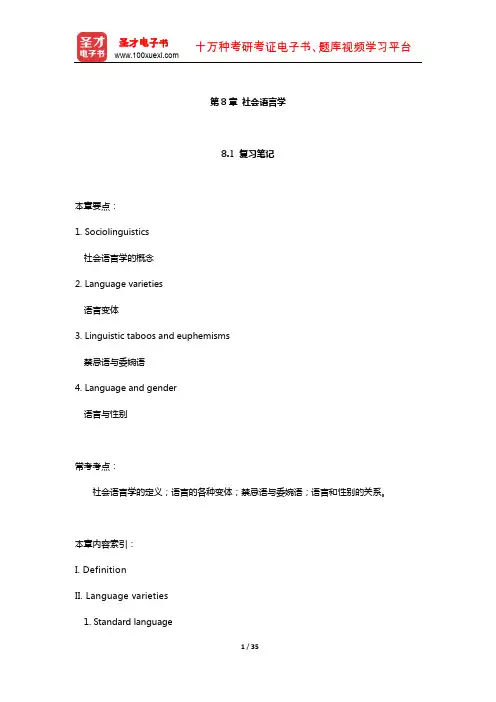
第8章社会语言学8.1 复习笔记本章要点:1. Sociolinguistics社会语言学的概念2. Language varieties语言变体3. Linguistic taboos and euphemisms禁忌语与委婉语4. Language and gender语言与性别常考考点:社会语言学的定义;语言的各种变体;禁忌语与委婉语;语言和性别的关系。
本章内容索引:I. DefinitionII. Language varieties1. Standard language2. Dialects3. Registers4. Pidgins and creolesIII. Choosing a code1. Diglossia2. Bilingualism and multilingualism3. Code-switchingIV. Linguistic taboos and euphemismsV. Language and gender1. Two focuses2. The correlation between sex and style of speechI. Definition (定义)Sociolinguistics is the study of language in relation to society. In sociolinguistics we are interested in how social factors influence the structure and use of language. It is the field that studies the relationships between language and society, between uses of language and the social structures in which the language users live.【考点:区分“研究社会的社会语言学”与“研究语言的社会语言学”】社会语言学是研究语言与社会关系的学科,研究社会因素是如何影响语言的结构和使用。
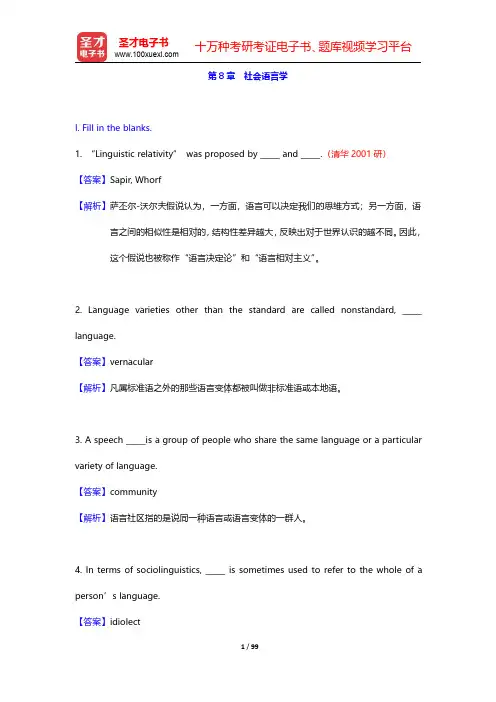
第8章社会语言学I.Fill in the blanks.1.“Linguistic relativity”was proposed by_____and_____.(清华2001研)【答案】Sapir,Whorf【解析】萨丕尔-沃尔夫假说认为,一方面,语言可以决定我们的思维方式;另一方面,语言之间的相似性是相对的,结构性差异越大,反映出对于世界认识的越不同。
因此,这个假说也被称作“语言决定论”和“语言相对主义”。
nguage varieties other than the standard are called nonstandard,_____ language.【答案】vernacular【解析】凡属标准语之外的那些语言变体都被叫做非标准语或本地语。
3.A speech_____is a group of people who share the same language or a particular variety of language.【答案】community【解析】语言社区指的是说同一种语言或语言变体的一群人。
4.In terms of sociolinguistics,_____is sometimes used to refer to the whole of a person’s language.【答案】idiolect【解析】从社会语言学的角度讲,个人习语指个人语言风格。
5.In many societies of the world,we find a large number of people who speak more than one language.As a characteristic of societies,_____inevitably results from the coming into contact of people with different cultures and different languages.【答案】bilingualism【解析】双语现象源于不同文化和不同语言相互交流的结果。
刘润清《新编语⾔学教程》笔记和课后习题(语⽤学)【圣才出品】第6章语⽤学6.1 复习笔记本章要点:1. Speech act theory⾔语⾏为理论2. Cooperative principle and its maxims合作原则及其准则3. Politeness principle礼貌原则常考考点:语⽤学的定义;语法分析与语⽤学的区别;微观语⽤学中的基本概念;宏观语⽤学中⾔语⾏为理论(发话⾏为、⾏事⾏为和取效⾏为);合作原则;实例分析⾔语⾏为、合作原则的违反和会话含义;礼貌原则。
本章内容索引:I. Pragmatics1. Definition of pragmatics2. Difference between pragmatics analysis and grammatical analysis3. Definition of micropragmatics and macropragmaticsII. Micropragmatics1. Reference2. Deixis3. Anaphora4. PresuppositionIII. Macropragmatics1. Speech Act Theory(1) Theory of the Illocutionary Act①Locutionary act②Illocutionary act③Perlocutionary act(2) Classification of Illocutionary Act①Representatives②Directives③Commissives④Expressives⑤Declarations(3) Indirect speech acts2. The Cooperative Principle (CP)(1) Cooperative Principle and Its Maxims(2) Violation of the Maxims3. Politeness Principle (PP)I. Pragmatics(语⽤学)【考点:名词解释】1. Definition of pragmatics(定义)Pragmatics is the study of speakers’intended meaning, or even the “invisible”meaning, that is, how hearers recognize what is meant even when it isn’t actually said or written.语⽤学是研究语⾔实际运⽤的学科,集中研究说话⼈意义、话语意义或语境意义。
第6章语用学6.1 复习笔记本章要点:1. Speech act theory言语行为理论2. Cooperative principle and its maxims合作原则及其准则3. Politeness principle礼貌原则常考考点:语用学的定义;语法分析与语用学的区别;微观语用学中的基本概念;宏观语用学中言语行为理论(发话行为、行事行为和取效行为);合作原则;实例分析言语行为、合作原则的违反和会话含义;礼貌原则。
本章内容索引:I. Pragmatics1. Definition of pragmatics2. Difference between pragmatics analysis and grammatical analysis3. Definition of micropragmatics and macropragmaticsII. Micropragmatics1. Reference2. Deixis3. Anaphora4. PresuppositionIII. Macropragmatics1. Speech Act Theory(1) Theory of the Illocutionary Act①Locutionary act②Illocutionary act③Perlocutionary act(2) Classification of Illocutionary Act①Representatives②Directives③Commissives④Expressives⑤Declarations(3) Indirect speech acts2. The Cooperative Principle (CP)(1) Cooperative Principle and Its Maxims(2) Violation of the Maxims3. Politeness Principle (PP)I. Pragmatics(语用学)【考点:名词解释】1. Definition of pragmatics(定义)Pragmatics is the study of speakers’intended meaning, or even the “invisible”meaning, that is, how hearers recognize what is meant even when it isn’t actually said or written.语用学是研究语言实际运用的学科,集中研究说话人意义、话语意义或语境意义。
第12章应用语言学I. Fill in the blanks.1. _____ is a method of foreign or second language teaching which makes use of translation and grammar study as the main teaching and learning activities. 【答案】Grammar-translation Method【解析】语法翻译法即在外语教学中主要运用翻译和语法学习为教学活动的方法.2. _____ is a grammar-based language teaching method in which principles of grammatical and lexical gradation are used and new teaching points presented and practiced through situations.【答案】Situational language teaching【解析】情景教学法基于语法的教学方法,强调在情境中呈现语法规则和词汇级别等教学点。
3. There are three principles of language testing: _____, _____ and _____.【答案】validity; reliability; practicality【解析】语言测试的三个原则:效度原则,信度原则及实用性原则。
Ⅱ. Multiple Choices.1. _____ deals with language application to other fields, particularly education.A. Linguistic geographyB. SociolinguisticsC. Applied linguisticsD. Comparative linguistics【答案】C【解析】应用语言学(Applied linguistics)是研究语言在各个领域中实际应用的语言学分支,尤其是在教学中的应用。
第12章应用语言学12.1 复习笔记本章要点:1. Language teaching method英语教学法的种类2. Language tests语言测试的种类3. The principles of language tests语言测试的原则常考考点:各个语言教学法的特点、理论基础、优缺点;语言测试主要的种类;语言测试的原则。
本章内容索引:I. Definition of Applied LinguisticsII. Language Teaching Method1. The Grammar-translation Method(1)Definition(2)Main features2. The Direct Method(1)Definition(2)Main features3. The Audiolingual Method(1)Definition(2)Main features(3)Theoretical base4. Situational Language Teaching(1)Definition(2)Main features(3)Theoretical base5. Functional Language Teaching(1)Definition(2)Main features(3)Theoretical base6. Communicative Language T eaching(1)Definition(2)Main features(3)Theoretical base7. Other ApproachesIII. Main Types of Language Tests1. Subjective and objective tests2. Discrete-point and integrative tests3. Criterion-referenced and norm-referenced tests4. Language aptitude tests5. Diagnostic testsIV. Principles of language Testing1. Validity2. Reliability3. PracticalityI. Definition of Applied Linguistics (应用语言学的定义)【考点:名词解释】Broadly speaking, applied linguistics refers to the study of language and linguistics in relation to language-related problems, such as lexicography, translation, etc. Applied linguistics uses information from linguistics with the aim to develop its own theoretical models of areas, such as syllabus design, speech therapy, language planning, stylistics etc. Narrowly speaking, applied linguistics refers to the study of second and foreign language learning and teaching, i.e. the study of language and linguistics in relation to language learning and teaching.从广义上讲,应用语言学是对与语言相关的语言问题及语言学问题的研究,例如词典编纂学,翻译等。
第7章语篇分析I. Fill in the blanks.1. ______ refers to ties and connections which exist within texts. They are also called formal links between sentences and between clauses.(人大2007研)【答案】Cohesion【解析】衔接不是一个句法概念,它指文本中存在的一种意义上的联系或关系,也包括句子或分句之间存在的一种形式上的联系。
2. ______ is the information that the addresser believes is known to the addressee, while ______ is the information that the addresser believes is not known to the addressee.【答案】Given information; new information【解析】已知信息是指说话者认为听话者已经知道的信息,而新信息是指说话者认为听话者不知道的信息。
3. ______ represents what the utterance is about; ______ is what is said about it. 【答案】The topic; the comment【解析】话题是谈话的主题,述题是围绕主题所谈论的内容。
Ⅱ. True or False.1. All languages have some differences in verb forms which are used to produce cohesion.(南开大学2005研)【答案】T【解析】语言中的动词会有不同的形式来连接上下文。
2. One of properties of the adjacency pairs is that the form and content of the first part depends on the type of the second part.【答案】F【解析】配租对话的其中一个特征是第二部分的内容与构成取决于第一部分。
第9章心理语言学Ⅰ. Multiple Choices.1. ______ is defined as a conscious process of accumulating knowledge of a second language usually obtained in school settings.A. CompetenceB. PerformanceC. LearningD. Acquisition【答案】C【解析】在学校里我们会学到第二语言,对第二语言知识的这种有意识的积累,叫做“学习”。
2. _____ is the study of psychological aspect of language.A. Language acquisitionB. Applied linguisticsC. PsycholinguisticsD. Pragmatics【答案】A【解析】语言习得是从心理学的角度来研究语言,主要研究儿童不自觉地自然地掌握母语的过程。
3. A child acquires his/her mother tongue invariably through these phases: _____, one-word, two-word and multiword.A. no-wordB. babblingC. talkingD. uttering【答案】B【解析】婴儿学习母语的过程分为四个阶段:呀呀学语阶段,单语词阶段,双语词阶段和多语词阶段。
4. The distinctive features of a speech variety may be all the following EXCEPT ______.A. lexicalB. syntacticC. phonologicalD. psycholinguistic【答案】D【解析】语言的变体可以是词法、句法、音位方面的变化。
第3章形态学3.1 复习笔记本章要点:1. Definition of Morphology形态学的定义2. Definition and Classification of Morphemes词素的定义及分类3. Morphs and Allomorphs词素变体4. Types of Word Formation词语构成的分类常考考点:词法的定义;曲折词与派生词;构词法(合成与派生);词素的定义;词素变体;自由词素;粘着词素(词根,词缀和词干)。
本章内容索引:I. MorphologyDefinition of MorphologyII. Morphemes1. Definition2. Types of Morphemes(1) Free morpheme(2) Bound morphemeIII. Morphs and AllomorphsDefinition of Morphs and AllomorphsIV. Types of Word Formation1. Compounding2. Derivation3. Other ways of word formation(1) Conversion(2) Backformation(3) Clipping(4) Blending(5) Acronym(6) InitialismI. Morphology形态学【考点:名词解释】Morphology, as a branch of linguistics, is the study of the internal structure, forms and classes of words.形态学作为语言学的一个分支,是研究词语的内部结构,形式及分类的一门科学。
II. Morpheme语素1. Definition定义Morpheme is the smallest unit of language, a unit that cannot be divided into further smaller units without destroying or drastically altering the meaning, whether it is lexical or grammatical.语素是最小的语言单位,不能再进一步分成更小的单位而不破坏或彻底改变词汇意义或语法意义。
2. Types of Morphemes (语素的类型)(1) Free morpheme (自由语素)【考点:名词解释】①Free morphemes are those which may occur alone or constitute words by themselves. All monomorphemes are free morphemes and polymorphemic words, which consist wholly of free morphemes, are compounds.②A word must contain an element that can stand by itself, that is, a free morpheme, such as talk. Such an element is called a root. A word may contain more than one root.③When they are used with bound morphemes, the basic word-form involved is technically known as the stem.④Free morphemes can be divided into two categories. The first one is the set of ordinary nouns, verbs and adjectives which carry the content of messages weconvey. These free morphemes are called lexical morphemes and, since we can create new lexical morphemes for the language rather easily, they are called an open class of words.⑤The second category of free morphemes are called functional morphemes. As we almost never add new functional morphemes to the language, they are called a closed class of words.①自由词素指能够单独出现或独立成词的语素。
所有的单语素词都是自由语素,由自由语素构成的多语素词为复合词。
②可以独立成词的部分,也就是自由词素被称作词根,一个词可以包含多个词根。
③当自由词素和粘着词素连用时,最基本的部分称作词干。
④自由词素分为两类。
一类是表达实义的名词,动词和形容词。
它们被称作词汇词素。
这类词素可以创造新词,因此属于开放式词汇。
⑤第二类叫做功能词素。
功能词素几乎不能创造新词,因此属于封闭式词汇。
(2) Bound morphemes (粘着语素)【考点:名词解释】①Some morphemes cannot normally stand alone, but function only as parts of words, e.g. -s, -er, -ed and -ing. Such morphemes are called bound morphemes②Bound morphemes are actually affixes. All affixes in English are bound. Affixes can be joined to the beginning of the root or stem, in which case they are called prefixes. Prefixes can change the meaning or function of the word..③Affixes can also be joined to the end of the root or stem, in which case they are called suffixes. Suffixes can also change the meaning or function of the word.④Bound morphemes can be classified into two categories. One category is derivational morphemes, which are used to make new words in the language and are often used to make words of a different grammatical category from the stem.⑤The other category is inflectional morphemes, which are not used to produce new words, but rather to show aspects of the grammatical function of a word.①一些词素不能够单独成词,但会起到一定的功能作用。
这种语素叫做黏着语素。
②黏着语素相当于词缀。
英语中所有的词缀都是黏着的。
附着在词根或词干前面的词缀叫做前缀,前缀可以改变词义或词语功能。
③词缀还可以放到词根或词干的后边,形成后缀,后缀也可以改变词义或功能。
④黏着语素可以分为两类。
一类叫做派生语素,用来创造与词干分属不同语法类别的新词。
⑤另一类叫做曲折语素。
屈折语素不用来创造新词,而是体现一个词的不同语法功能。
III. Morphs and Allomorphs (语素和语素变体)Morphs are the smallest meaningful phonetic segments of an utterance on the level of parole.An allomorph is a member of a set of morphs which represent the same morpheme. Allomorphs are phonological or orthographic variants of the same morpheme.语素变体是最小的有意义的语音单位。
那些代表同一语素的不同形素叫做该语素的语素变体。
IV. Types of Word Formation (构词法)【考点:词的形成方法】1. Compounding (复合词)By means of compounding, two free morphemes are combined to form a compound. Compounds have strict patterns. The first element in the compound receives the main stress, but it is generally the second element that determines the compound’s new word class.两个自由语素结合形成复合词。
复合词有严格的形式。
复合词的重音在前一部分,但词义通常由第二部分决定。
2. Derivation (派生词)Derivation is done by adding affixes to other words or morphemes. In contrast to compounding, a derivational word consists of at least a free morpheme and a bound morpheme.派生词是通过添加词缀来形成的。
和复合词不同的是,派生词至少包含一个自由语素和一个粘着语速。
3. Other ways of word formation (其他构词法)①Conversion (转换法)Many words have more than one part of speech. A noun can become a verb easily and a verb can be used as a noun. Such instances are called conversion.Conversion is also called zero derivation.很多词语包含多种词性。